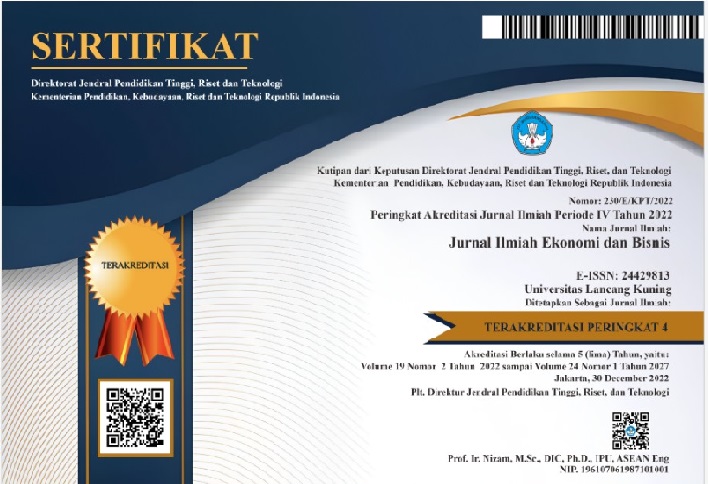ANALISIS FAKTOR-FAKTOR YANG MEMPENGARUHI NIAT PENGGUNAAN E-MONEY MELALUI APLIKASI PEMBAYARAN BERBASIS DIGITAL MENGGUNAKAN MODEL UTAUT
DOI:
https://doi.org/10.31849/jieb.v18i1.5465Keywords:
UTAUT; e-money; digital-based payment applicationsAbstract
Perkembangan teknologi saat ini mendorong penggunaan e-money tidak hanya pada kartu pembayaran, tetapi juga melalui aplikasi pembayaran berbasis digital. Penelitian tersebut bertujuan untuk mengetahui faktor-faktor apa saja yang mempengaruhi niat seseorang untuk menggunakan e-money melalui aplikasi pembayaran berbasis digital dengan model UTAUT. Pengumpulan data dilakukan dengan menyebarkan kuesioner secara online melalui google docs. Sampel yang digunakan dalam penelitian ini adalah 290 pengguna e-money di Kota Batam. Berdasarkan hasil pengujian hipotesis dengan menggunakan WrapPLS 7.0, terdapat lima hipotesis yang mendukung, sedangkan dua hipotesis lainnya tidak mendukung. Riset ini berkontribusi pada program pemerintah untuk mewujudkan ekonomi digital di berbagai sektor industri, khususnya untuk memberikan solusi transaksi non tunai di Indonesia
References
Agusta, J., Adi, W., Muksit, H., Hutabarat, K., & Hanzdima, A. (2018, March 5). Mobile Payments In Indonesia: Race to Big Data Domination. Diakses dari MDI Ventures by Telkom Indonesia: https://mdi.vc/whitepaper/detail/3/Mobile%20Payments%20In%20Indonesia%3A%20Race%20to%20Big%20Data%20Domination
Al-Okaily, M., Lutfi, A., Alsaad, A., Taamneh, A., & Alsyouf, A. (2020). The Determinants of Digital Payment Systems’ Acceptance under Cultural Orientation Differences: The Case of Uncertainty Avoidance. Technology in Society, 63, 101367. doi:https://doi.org/10.1016/j.techsoc.2020.101367
Al-Saedi, K., Al-Emran, M., Ramayah, T., & Abusham, E. (2020). Developing a general extended UTAUT model for M-payment adoption. Technology in Society, 62, 101293. doi:https://doi.org/10.1016/j.techsoc.2020.101293
Baishya, K., & Samalia, H. V. (2020). Extending unified theory of acceptance and use of technology with perceived monetary value for smartphone adoption at the bottom of the pyramid. International Journal of Information Management, 51, 102036. doi:https://doi.org/10.1016/j.ijinfomgt.2019.11.004
Boonsiritomachai, W., & Pitchayadejanant, K. (2017). Determinants affecting mobile banking adoption by generation Y based on the Unified Theory of Acceptance and Use of Technology Model modified by the Technology Acceptance Model concept. Kasetsart Journal of Social Sciences, xxx, 1-10. doi:https://doi.org/10.1016/j.kjss.2017.10.005
BPS Indonesia. (2019). Statistik E-Commerce 2019. Badan Pusat Statistik Indonesia.
Chawla, D., & Joshi, H. (2019). Consumer attitude and intention to adopt mobile wallet in India – An empirical study. International Journal of Bank Marketing, 37(7), 1590-1618. doi:10.1108/IJBM-09-2018-0256
Dehghan, F., & Haghighi, A. (2015). E-money regulation for consumer protection. International Journal of Law and Management, 610-620. doi:10.1108/IJLMA-06-2014-0042
Devita, V. D. (2019, August 12). Siapa Aplikasi E-wallet dengan Pengguna Terbanyak di Indonesia? Diambil kembali dari Iprice: https://iprice.co.id/trend/insights/e-wallet-terbaik-di-indonesia/
Gunawan, H., Sinaga, B. L., & WP, S. P. (2019). Assessment of the Readiness of Micro, Small and Medium Enterprises in Using E-money Using the Unified Theory of Acceptance and Use of Technology (UTAUT) Method. Procedia Computer Science, 161, 316-323. doi:https://doi.org/10.1016/j.procs.2019.11.129
Gupta, K., & Arora, N. (2020). Investigating consumer intention to accept mobile payment systems through unified theory of acceptance model. South Asian Journal of Business Studies, 9(1), 88-114. doi:10.1108/SAJBS-03-2019-0037
Gurkaynak, G., & Yilmaz, I. (2015, June). Regulating payment services and electronic money: A comparative regulatory approach with a specific focus on Turkish legislation. Computer Law & Security Review, 31(3), 401-411. doi:https://doi.org/10.1016/j.clsr.2015.03.009
Hair Jr, J., Black, W. C., Babin, B. J., & Anderson, R. E. (2010). Multivariate Data Analysis: A Global Perspective. (7, Penyunt.) Prentice Hall.
Hartono, J. (2008). Sistem Informasi Keperilakuan. Andi Publisher.
Junadi, & Sfenrianto. (2015). Model of Factors Influencing Consumer’s Intention To Use E-Payment System in Indonesia. Procedia Computer Science, 59, 214 – 220. doi:10.1016/j.procs.2015.07.557
Keong, M. L., Ramayah, T., Kurnia, S., & Chiun, L. M. (2012). Explaining intention to use an enterprise resource planning (ERP) system: an extension of the UTAUT model. Business Strategy Series, 13(4), 173 - 180. doi:https://doi.org/10.1108/17515631211246249
Khatimah, H., & Halim, F. (2014, July). Consumers’ Intention to Use e-money in Indonesia Based on Unified Theory of Acceptance and Use of Technology (UTAUT). American-Eurasian Journal of Sustainable Agriculture, 8(12), 34-40. Diambil kembali dari http://repo.uum.edu.my/id/eprint/12776
Lynch, D. C., & Lundquist, L. (1996). Digital Money The New Era Of Internet Commerce (1st ed.). New York, United States: John Wiley and Sons Ltd.
Nag, A. K., & Gilitwala, B. (2019, November). E-Wallet- Factors Affecting Its Intention to Use. International Journal of Recent Technology and Engineering (IJRTE), 8(4). doi:10.35940/ijrte.D6756.118419
Octabriyantiningtyas, D., Suryani, E., & Jatmiko, A. R. (2019). Modeling Customer Satisfaction with the Service Quality of E-money in Increasing Profit of PT. Telekomunikasi Indonesia. Procedia Computer Science, 161, 943–950. doi:10.1016/j.procs.2019.11.203
Odoom, R., & Kosiba, J. P. (2020). Mobile money usage and continuance intention among micro enterprises in an emerging market – the mediating role of agent credibility. Journal of Systems and Information Technology, 22(1), 97-117. doi:10.1108/JSIT-03-2019-0062
Patil, P., Tamilmani, K., Rana, N. P., & Raghavan, V. (2020). Understanding consumer adoption of mobile payment in India: Extending Meta-UTAUT model with personal innovativeness, anxiety, trust, and grievance redressal. International Journal of Information Management, 54, 102144. doi:https://doi.org/10.1016/j.ijinfomgt.2020.102144
PWC Research. (2019). It’s time for a consumer-centred metric: introducing ‘return on experience’. Diambil kembali dari PWC Global: https://www.pwc.com/ee/et/publications/pub/Consumer-Insight-Survey-2019-report.pdf
Rana, N. P., Dwivedi, Y. K., Lal, B., Williams, M. D., & Clement, M. (2017). Citizens’ adoption of an electronic government system: towards a unified view. Inf Syst Front, 19, 549–568. doi:10.1007/s10796-015-9613-y
Shaw, N. (2014). The mediating influence of trust in the adoption of the mobile wallet. Retailing and Consumer Services, 21, 449–459. doi:http://dx.doi.org/10.1016/j.jretconser.2014.03.008
Sivathanu, B. (2019). Adoption of digital payment systems in the era of demonetization in India. Journal of Science and Technology Policy Management, 10(1), 143-171. doi:10.1108/JSTPM-07-2017-0033
Tak, P., & Panwar, S. (2017). Using UTAUT 2 Model to Predict Mobile App based shopping: Evidences from India. Journal of Indian Business Research, 9(3), 248-264. doi:https://doi.org/10.1108/JIBR-11-2016-0132
Taufan, A., & Yuwono, R. T. (2019, July). Analysis of Factors That Affect Intention to Use e-Wallet through the Technology Acceptance Model Approach (Case Study: GO-PAY). International Journal of Science and Research (IJSR), 8(7). doi:10.21275/ART2020219
Ting, H., Yacob, Y., Liew, L., & Lau, W. M. (2016). Intention to Use Mobile Payment System: A Case of Developing Market by Ethnicity. Procedia - Social and Behavioral Sciences, 224, 368 – 375. doi:10.1016/j.sbspro.2016.05.390
Venkatesh, V., Morris, M. G., Davis, G. B., & Davis, F. D. (2003, Sept). User Acceptance of Information Technology: Toward a Unified View. MIS Quarterly, 27(3), 425-478. doi:10.2307/30036540
Venkatesh, V., Thong, J. Y., & Xu, X. (2012, March). Consumer Acceptance and Use of Information Technology: Extending the Unified Theory of Acceptance and Use of Technology. MIS Quarterly, 36(1), 157-178. doi:10.2307/41410412
Verkijika, S. F. (2020). An affective response model for understanding the acceptance of mobile payment systems. Electronic Commerce Research and Applications, 39, 100905. doi:https://doi.org/10.1016/j.elerap.2019.100905
Verma, S., Chaurasia, S. S., & Bhattacharyya, S. S. (2020). The effect of government regulations on continuance intention of in-store proximity mobile payment services. International Journal of Bank Marketing, 38(1), 34-62. doi:10.1108/IJBM-10-2018-0279
Yu, C.-S. (2014, June). Consumer Switching Behavior From Online Banking To Mobile Banking. International Journal of Cyber Society and Education, 7(1), 1-28. doi:10.7903/ijcse.1108.












 This work is licensed under a Attribution 4.0 International (CC BY 4.0)
This work is licensed under a Attribution 4.0 International (CC BY 4.0) 